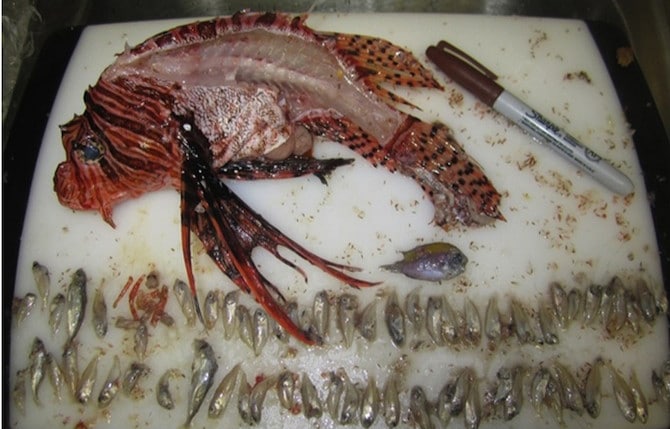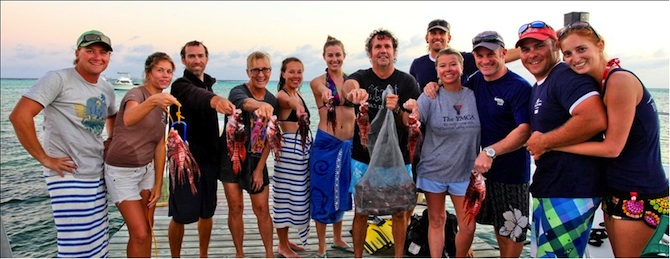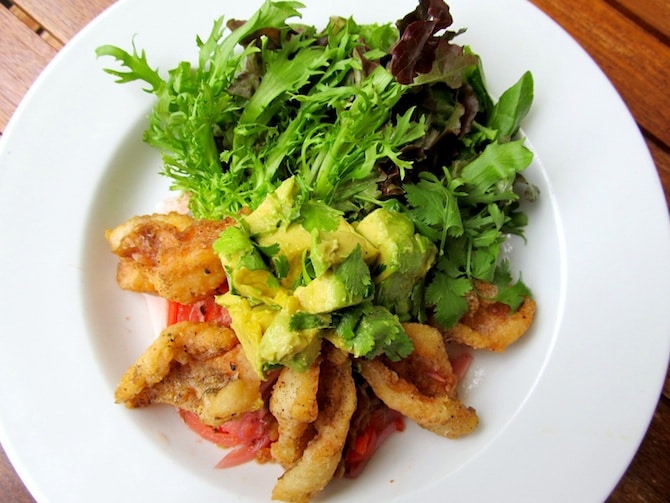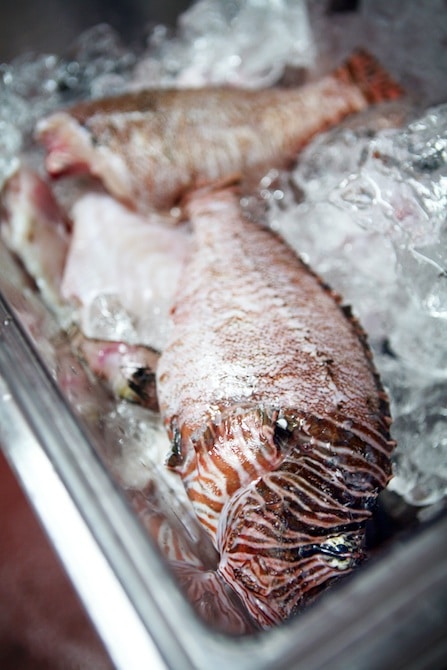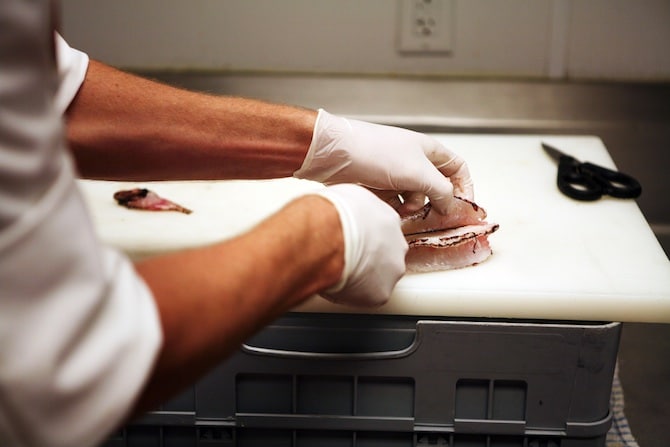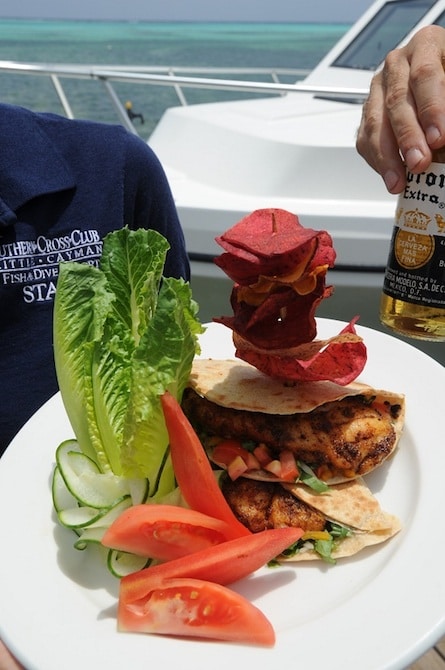Caribbean Crisis: How Eating Lionfish Can Help Save The Planet

Lionfish are gnarly-looked creatures. Photo courtesy of Florida Fish & Wildlife.
One of the sea's gnarliest looking creatures, the lionfish appears like a crazy cross between a zebra, butterfly and Egyptian Pharaoh with bold stripes, a sourpuss mouth and ornate tentacles fit for Cairo's ancient rulers. Unfortunately, the appetite and hunting prowess of a lionfish is just as impressive as its venomous spikes and unmistakable patterns: A single lionfish can eradicate up to 90 percent of a reef's marine species in just five weeks, according to the World Lionfish Hunters Association. This can cause huge problems, as reefs die, already over-fished species populations decrease, and destinations relying on dive tourism become less sought after.
This isn't an isolated incident, as today the lionfish invasion stretches from Massachusetts to Venezuela and encompasses the entire Gulf of Mexico and every shoreline in its water. Luckily, those with an adventurous palate can help slow down the problem simply by going out to dinner, as certain restaurants cull and serve lionfish as a sustainable delicacy.
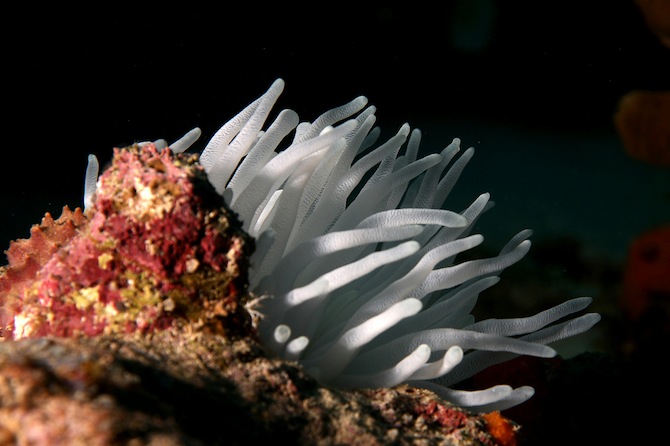
Underwater beauty. Photo courtesy of LASZLO ILYES.
How Did They Get Here?
No one knows exactly how the lionfish got from the Indian and Pacific Oceans, its native habitat, to the Gulf of Mexico and Atlantic Ocean, where it is currently thriving. Dr. Thomas K. Frazer, a lionfish expert and director of the University of Florida's School of Natural Resources and Environment, says the first confirmed report of a lionfish was in the Florida Keys in 1985, but most researchers believe the introduction that led to widespread abundance occurred in the mid 1990s.
Exactly how the lionfish reached the Gulf is a mystery, but there is a clue: because there is little genetic variation among lionfish living in the Gulf and Atlantic Ocean, scientists think the fish were introduced to the area at one specific point in time. While some suppose the fish got loose when the contents of a single aquarium in Miami blew into the ocean during Hurricane Andrew in 1992, others say exotic pet owners who either tired of their lionfish or could no longer raise them simply released their aquarium trophies into the ocean. Yet another theory holds that the fish got sucked up into the ballast water of large container ships and were later released into the Gulf.
The Problem
However they arrived, lionfish are doing tremendous harm to local coral reefs. They have no natural predators in the Gulf of Mexico and Atlantic Ocean, and their stomachs can expand up to 30 times its normal size, allowing a single lionfish to cram in a tremendous amount of food. And they're not picky eaters: Lionfish will devour almost anything that fits inside their mouths.
Here's the problem: When lionfish feed on fish that graze on algae, corals may become overgrown with seaweed and die. In fact, according to Neil van Niekerk, manager of Little Cayman's Southern Cross Club — a Little Cayman hotel passionate about preserving local reefs — and coordinator of the island's lionfish culling efforts, studies have shown lionfish can reduce local biodiversity by up to 80%, killing herbivorous fish that keep algae from overtaking coral, as the green non-flowering plant grows infinitely faster. If these corals don't receive enough light they will die, and because algae are taking over the reef there is no room left for new corals to settle.
Additionally, Dr. Frazer explains that because lionfish aren't endemic many local fish don't recognize them as predators, leaving them more vulnerable to attack. To top it all off, a female lionfish can have up to 2 million babies each year, making it difficult to reduce the population through hunting alone.
Community Efforts
Still, in places where people rely on coral reefs for their livelihood – both through fishing itself and by bringing in tourists eager to snorkel and scuba dive – there are serious efforts underway to get the lionfish population under control and save the reefs. Nowhere are those efforts more advanced than on the Cayman Islands, which is home to 365 official dive sites recognized by the destinations' Dive365 Program, all marked by moorings.
All three islands — Grand Cayman, Cayman Brac and Little Cayman – have culling programs to get rid of lionfish by brute force. Of the three, Little Cayman's eponymous Community Cull is the most comprehensive eradication effort. The four companies that offer diving expeditions to tourists take turns providing a boat and resources for the hunt each week, where divers head underwater with spears to catch the lionfish — which eventually get turned into a tasty meal — before reporting the data. The Central Caribbean Marine Institute and the University of Florida manage the program and audit the results. With local culling programs like this, the reefs have the potential to remain intact and biodiversity and biomass strong. Furthermore, people can become further educated about lionfish and their negative effects, an important part of the process to recovering the area. While it's difficult to quantify because a lionfish invasion in the Atlantic and Gulf of Mexico has never happened before, researchers believe the numbers of native fish on reef sites where lionfish are removed regularly (culled) are about double that of unculled reefs.
But ultimately, hunting alone isn't likely to solve the problem, experts say. "People can try to remove the lionfish in a concerted manner," explains Frazer. "It's unlikely we're going to get rid of lionfish as their numbers at this point are too great; however, people can identify important areas of impact and manually remove them. We want to organize these efforts in a way so we learn something about how to better manage lionfish along the way."
Eating For A Cause
That's where a little market-making goes a long way. If a concerted effort to get rid of lionfish isn't enough, why not make them into a sought-after delicacy and hope the resulting demand is enough to reduce the population? And while over-fishing is usually something to worry about, here we're looking at a fish that people can hunt and eat as much of they want. At Southern Cross Club they serve lionfish any style, although mainly as tacos. According to van Niekerk, most guests who sample the white, flaky fish love the fact it has no inherent fishy flavor, but instead absorbs the tastes of whatever it's cooked with.
Michael's Genuine Food & Beverage, one of the Cayman Islands' best restaurants, has also signed on for the lionfish cause. Named one of the Top 50 New Restaurants in 2013 by Bon Appetit magazine, restaurant owner and chef Michael Schwartz is a James Beard Award winner. His menu consists of dishes made with fresh, local ingredients, including lionfish. The mild yet firm-textured fish — think the flavor of grouper with the feel of whitefish — can be prepared in various ways, although Michael's Genune Chef de Cuisine Thomas Tennant recommends fried, which preserves the moisture in the fish. He also enjoys serving it as a ceviche, as the delicate texture of lionfish in raw form is not "tiresome for the palate."
It all started when Michael's Genuine was approached by Jason Washington of Ambassador Divers, a 5-star PADI IDC scuba diving operator on Grand Cayman, and the Cayman Islands Department of Environment, a government agency responsible for managing the Cayman Islands' natural resources, who told them about the lionfish issue and asked them to showcase it as a viable food source.
"As the owner of Ambassador Divers I felt it was my duty to help try and solve the issue of the invasion," explains Washington. "I knew if I could create a demand for the fish, we would have a better chance of not being completely over run by the invader."
Washington approached Chef Tennant, who agreed to cook the fish caught during a series of lionfish tournaments spearheaded by Washington, and serve it to the public, free of charge, to help raise awareness. At this time it was early 2011, and nobody on the island had eaten lionfish before; however, during the event they offered about 600 fish, which ended up being a success. It was the beginning of what led to 14 local restaurants in the Cayman Islands serving lionfish.
Michael's Genuine had already been using invasive Casarina wood to stoke their wood oven, so it was logical to take on another sustainable effort. While much of the staff also participate in culling efforts and the restaurant pays divers for the lionfish they catch, Chef Tennant believes their most powerful approach is education.
"The most influential ways that we help to control the population is to create a demand for the fish and lessen the demand for endangered and threatened fish by not serving them," he explains. "By not serving Nassau grouper, we can educate our guests on the cause and effects of their decisions when making their dining choices. Through education, we can make positive choices that impact our marine environment."
Skeptical Diners
Of course, patrons were skeptical at first, mainly because they didn't understand the difference between poisonous fish, which contain poisons and can be harmful when ingested or touched, and venomous fish — like lionfish — where the poison must be injected; however, once people began sampling the seafood and realizing they weren't going to die, it became one of the Cayman Islands' most popular food items. According to van Niekerk, he would give lectures each week to guests and offer free lionfish samples of the lionfish. Now, they have trouble keeping it in stock, despite the weekly culls. Chef Tennant agrees it took time to educate the public and get them used to the idea of eating lionfish, but now that they do, it's in high demand.
"The amount of people who order lionfish on a daily basis varies from day to day," he explains. "What I can tell you is that on average, in a good weather week, we will receive 80 pounds of fish per week. We constantly sell out. People who try it, love it. Those who are curious will order it. Guests will tell everyone that they ate an invasive fish and feel great about it."
As it turns out, when it's on the plate instead of gobbling up endemic species, there's a lot to like about the lionfish. It's high in heart-healthy, disease-fighting omega 3 fatty acids, and the chefs send the bones, head, and scales to be used can be used for healthy composting at local farms. It's even considered a delicacy, due to its sustainability appeal as well as the fact that the method of catching the fish is challenging, diving for them with spears instead of fishing with a rod.
But chefs who prepare the fish also need to be a little bit brave. Lionfish have 18 venomous spines that can cause extreme pain, possible necrosis and often secondary infections which require antibiotics. In fact, it's not uncommon for those who have been stung to say they've contemplated "cutting their arm off with a machete," according to van Niekerk. But restaurant patrons need not worry,, as local chefs perfectly fillet the fish to remove the spines, and from the restaurant tables the diners only thought need be whether to order it fried or grilled — hold the venom.
Additionally, because chefs are eager for people to eat the invasive fish, it's sometimes priced cheaper than the other seafood options, although because of the work that goes into preparing lionfish this is not always the case.
"Lionfish, in my opinion, are quite tasty and would be a welcomed selection by many on a restaurant menu," says Dr. Frazer. "In the short term, this may be one strategy to help reduce the numbers of lionfish that occur on coral reefs and other habitats. With that said, the hope is that lionfish numbers will ultimately be reduced so that they are not abundant enough to be available for restaurants to serve."
So eat it while you can!
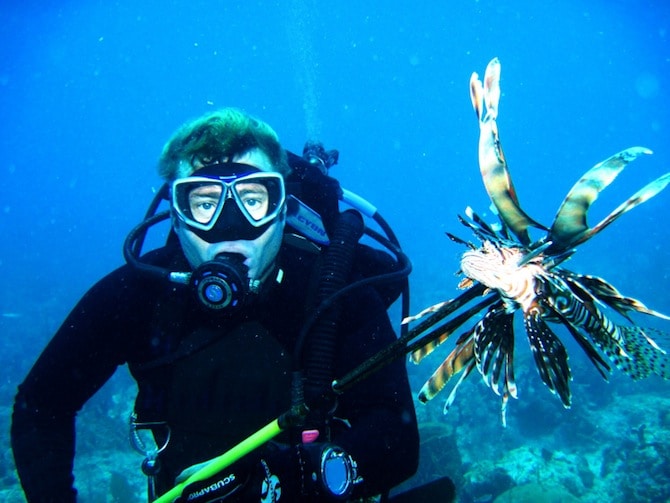
Hunting for lionfish. Photo courtesy of Florida Fish and Wildlife.
Working For Your Food
For adventurous travelers who want a more immersive experience, a lionfish cull and cooking excursion is an option. Ocean Frontiers, a dive and snorkel shop and dive boat operator in the Cayman Islands, hosts a Red Lionfish Hunt. During the excursion, divers (you must have made a previous dive in the Cayman Islands to participate) will separate into teams led by a Divemaster to go on a one-tank dive to help cull lionfish from the reefs, while learning how to properly remove them. Back on the boat, the lionfish are weighed to see who caught the most, smallest and largest lionfish.
Next it's on to the fun part: an exotic and eco-friendly meal of grilled lionfish. This allows for a more immersive experience where you'll truly see — and taste — firsthand the lionfish epidemic.
While the Caymans is by far and away the most active in its lionfish population-control efforts, there are also a number of U.S.-based projects. Throughout Florida and the Caribbean the Reef Environmental Education Foundation, an organization focused on marine conservation, hosts Lionfish Derbies where people compete to collect and remove as many lionfish as possible, snorkeling and diving from sunrise until 5pm using nets and spears.
According to Lad Akins, the Director of Special Projects for Reef.org, the derbies provide an opportunity to educate the public while combating the problem, as even those not hunting for lionfish are invited to watch the fish being brought in and prepared by chefs (as well as sample some for themselves). As for the divers, teams are trained on lionfish culling the night before, and prizes are awarded for shortest, longest and largest quantity of lionfish. A bonus is these lionfish derbies also provide samples to researchers, who can examine their stomach contents and answer questions about genetics, reproduction and other biological issues.
The Future
So what does the future look like for reefs affected by invasive lionfish? According to Dr. Frazer, there is hope, although it's anyone's guess how long it will take. Looking at the successes on Little Cayman, we can at least now see it's possible to carry out culling and removal efforts and achieve success. For example, in 2012 Dr. Frazer along with five other researchers collected quantitative estimates of catch per unit effort (CPUE) — calculated by taking the number of lionfish removed and dividing it by the sum of the diver's bottom times in hours — and analyzed dive sites around Little Cayman between January 2011 and June 2011.
Each fish collected was measured and also had its stomach contents analyzed. Three focus sites for the study were Bus Stop, Mixing Bowl, and Blacktip Boulevard. Seven research culls were performed at Blacktip Boulevard, during which the number of lionfish was reduced from 175 lionfish per hectare to 13 lionfish per hectare. Additionally lionfish culled in January 2011 measured 95 to 395 millimeters in length, compared to a shortened 140 to 295 millimeters — 83% being smaller than 220 millimeters — in June 2011.
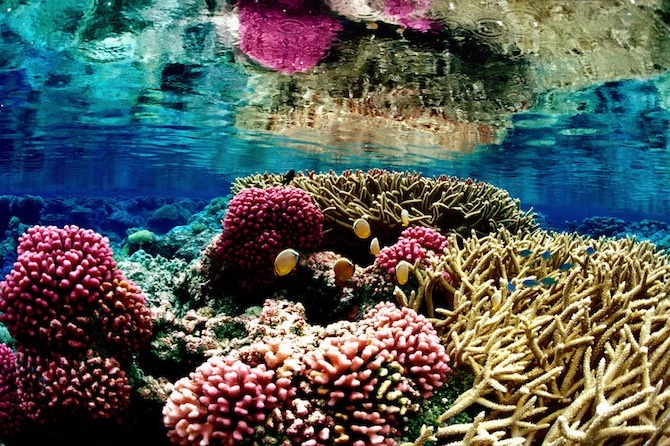
Vibrant coral reefs. Photo courtesy of Jim Maragos.
What's positive about this is smaller lionfish not only eat less, but tend to eat shrimp rather than fish (many of which are already threatened or perform essential ecological functions that promote the health and integrity of coral reefs). Bus Stop and Mixing Bowl were researched during one to three dive trips, after which time the lionfish problem was considered by locals to be under sufficient control that the use of community resources to remove lionfish weren't warranted in those areas.
It's also worth noting that, according to Dr. Frazer, thousands of fish have been removed around Little Cayman Island, most notably its Bloody Bay Marine Park, and sightings nowadays are much less common than they once were. In the control areas outside of the park, this is not the case, with high densities of lionfish and dropping numbers of native fish species.
"I think the potential to manage the lionfish — at least at a local level — shows we can protect some of the most valuable coral reef areas. Over time as we learn more about the lionfish we'll also learn how to better manage them. It is also possible that native fish will learn to prey on lionfish and help in that regard. I believe this is something that's already beginning to happen in some locations."
In the meantime, heading down to the Cayman Islands for a lionfish cull or delicious lionfish dinner offers a unique dining experience not available in most restaurants around the world.
Have you tried lionfish or taken part in a cull? Please share your experience in the comments below.
Also Check Out:
Farm-To-Fork Dining And Kitchen Garden Cocktails...In The Cayman Islands?
JetBlue Partnership Steers Toward Long-Term Health Of Caribbean Beaches
The World's Most Indulgent Chocolate Spas
The post Caribbean Crisis: How Eating Lionfish Can Help Save The Planet appeared first on Epicure & Culture.
